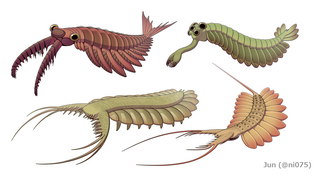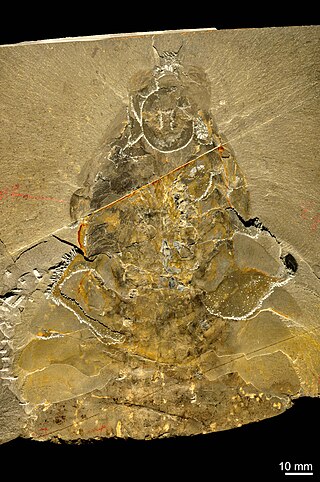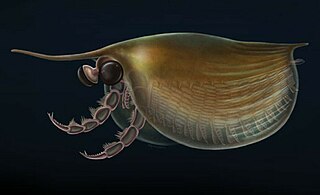
Dinocaridida is a proposed fossil taxon of basal arthropods that flourished in the Cambrian period with occasional Ordovician and Devonian records. Characterized by a pair of frontal appendages and series of body flaps, the name of Dinocaridids refers to the suggested role of some of these members as the largest marine predators of their time. Dinocaridids are occasionally referred to as the 'AOPK group' by some literatures, as the group compose of Radiodonta, Opabiniidae, and the "gilled lobopodians" Pambdelurion and Kerygmachelidae. It is most likely paraphyletic, with Kerygmachelidae and Pambdelurion more basal than the clade compose of Opabiniidae, Radiodonta and other arthropods.

The Emu Bay Shale is a geological formation in Emu Bay, South Australia, containing a major Konservat-Lagerstätte. It is one of two in the world containing Redlichiidan trilobites. The Emu Bay Shale is dated as Cambrian Series 2, Stage 4, correlated with the upper Botomian Stage of the Lower Cambrian.

Anomalocaris is an extinct genus of radiodont, an order of early-diverging stem-group arthropods.

Peytoia is a genus of hurdiid radiodont, an early diverging order of stem-group arthropods, that lived in the Cambrian period, containing two species, Peytoia nathorsti from the Miaolingian of Canada and Peytoia infercambriensis from Poland, dating to Cambrian Stage 3. Its two frontal appendages had long bristle-like spines, it had no fan tail, and its short stalked eyes were behind its large head.

Amplectobelua is an extinct genus of late Early Cambrian amplectobeluid radiodont, a group of stem arthropods that mostly lived as free-swimming predators during the first half of the Paleozoic Era.

Anomalocarididae is an extinct family of Cambrian radiodonts, a group of stem-group arthropods.

Megacheira is an extinct class of predatory arthropods defined by their possession of spined "great appendages". Their taxonomic position is controversial, with studies either considering them stem-group euarthropods, or stem-group chelicerates. The homology of the great appendages to the cephalic appendages of other arthropods is also controversial. Uncontested members of the group were present in marine environments worldwide from the lower to middle Cambrian.

Isoxys is a genus of extinct bivalved Cambrian arthropod; the various species of which are thought to have been freely swimming predators. It had a pair of large spherical eyes, and two large frontal appendages used to grasp prey.

Panlongia was a small-sized marine arthropod, with an oval-shaped non-calcified exoskeleton. Both the head shield and the tail shield are semi-circular. In between the cephalon and pygidium are four thoracic body segments (somites). The cephalon occupies approximately ⅓ of the body length, the thorax ¼ and pygidium about 45%. Panlongia lived during the late Lower Cambrian (Botomian) in what is today South China. In Panlongia spinosa the edge of the exoskeleton carries several small sawtooth-like spines, that are absent in P. tetranodusa.

Radiodonta is an extinct order of stem-group arthropods that was successful worldwide during the Cambrian period. They may be referred to as radiodonts, radiodontans, radiodontids, anomalocarids, or anomalocaridids, although the last two originally refer to the family Anomalocarididae, which previously included all species of this order but is now restricted to only a few species. Radiodonts are distinguished by their distinctive frontal appendages, which are morphologically diverse and used for a variety of functions. Radiodonts included the earliest large predators known, but they also included sediment sifters and filter feeders. Some of the most famous species of radiodonts are the Cambrian taxa Anomalocaris canadensis, Hurdia victoria, Peytoia nathorsti, Titanokorys gainessii, Cambroraster falcatus and Amplectobelua symbrachiata, the Ordovician Aegirocassis benmoulai and the Devonian Schinderhannes bartelsi.

Hurdia is an extinct genus of hurdiid radiodont that lived 505 million years ago during the Cambrian Period. Fossils have been found in North America, China and the Czech Republic.

Stanleycaris is an extinct, monotypic genus of hurdiid radiodont from the middle Cambrian (Miaolingian). The type species is Stanleycaris hirpex. Stanleycaris was described from the Stephen Formation near the Stanley Glacier and Burgess Shale locality of Canada, as well as Wheeler Formation of United States. The genus was characterized by the rake-like frontal appendages with robust inner spines.

Caryosyntrips ("nutcracker") is an extinct genus of stem-arthropod which known from Canada, United States and Spain during the middle Cambrian.

Emucarididae is an extinct family of soft-shelled trilobite-like arthropods (nektaspids) from the Lower Cambrian of South Australia and South China. It contains only two genera – Emucaris and Kangacaris. Two species were described in 2010 from specimens recovered from Emu Bay Shale Lagerstätte, one species in 2012 from the Maotianshan Shales. It is classified under the order Nektaspida, and is a sister-group to the families Liwiidae and Naraoiidae.

Emucaris fava is an extinct species of soft-shelled trilobite-like arthropod of the nektaspid order from the Lower Cambrian of South Australia. It is the only species classified under the genus Emucaris.

Amplectobeluidae is a clade of Cambrian radiodonts. It currently includes five definitive genera, Amplectobelua, Lyrarapax, Ramskoeldia, Guanshancaris and a currently unnamed genus from the lower Cambrian aged Sirius Passet site in Greenland. There is also a potential fifth genus, Houcaris, but that genus has become problematic in terms of its taxonomic placement.

Ramskoeldia is a genus of amplectobeluid radiodont described in 2018. It was the second genus of radiodont found to possess gnathobase-like structures and an atypical oral cone after Amplectobelua. It was discovered in the Chengjiang biota of China, the home of numerous radiodontids such as Amplectobelua and Lyrarapax.

Houcaris is a possibly paraphyletic radiodont genus, tentatively assigned to either Amplectobeluidae, Anomalocarididae or Tamisiocarididae, known from Cambrian Series 2 of China and the United States. It contains two species, Houcaris saron and Houcaris magnabasis, both of which were originally named as species of the related genus Anomalocaris. The genus Houcaris was established for the two species in 2021 and honors Hou Xianguang, who had discovered and named the type species Anomalocaris saron in 1995 along with his colleagues Jan Bergström and Per E. Ahlberg.

Laminacaris is a genus of extinct stem-group arthropods (Radiodonta) that lived during the Cambrian period. It is monotypic with a single species Laminacaris chimera, the fossil of which was described from the Chengjiang biota of China in 2018. Around the same time, two specimens that were similar or of the same species were discovered at the Kinzers Formation in Pennsylvania, USA. The first specimens from China were three frontal appendages, without the other body parts.

Oestokerkus is an extinct genus of Cambrian megacheiran arthropod known from the Emu Bay Shale of Kangaroo Island, Australia. It belongs to the family Leanchoiliidae. It had a large head shield that was more than a third of the trunk's length, as well as a large pair of eyes. The great appendages have long flagellae projecting from them. The head shield probably had two pairs of cephalic appendages. The trunk has 11 segments. The exopods of the biramous limbs are fringed with long setae. The body ended with a telson, which was probably dorsally flattened.






















